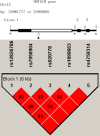Polymorphisms of long non-coding RNA HOTAIR with breast cancer susceptibility and clinical outcomes for a southeast Chinese Han population
- PMID: 29423075
- PMCID: PMC5790492
- DOI: 10.18632/oncotarget.23343
Polymorphisms of long non-coding RNA HOTAIR with breast cancer susceptibility and clinical outcomes for a southeast Chinese Han population
Abstract
Hox transcript antisense intergenic RNA (HOTAIR) is a well-known long non-coding RNA (lncRNA) which participates in tumorigenesis and progress of multiple cancers. However, the associations among polymorphisms on HOTAIR, breast cancer (BC) susceptibility and clinical outcomes have remained obscure. In this case-control study, we assessed the interaction between three lncRNA HOTAIR single nucleotide polymorphisms (SNPs) (rs1899663, rs4759314 and rs7958904) on the risk and clinical outcome of breast cancer in a Chinese Han population. In total, 969 breast cancer cases and 970 healthy controls were enrolled in this study. Associations among genotypes, BC risk and survival were evaluated by univariate and multivariate logistic regression to estimate the odds ratio (OR), hazard ratio (HR) and its 95% confidence interval (CI). The disease-free survival (DFS) and overall survival (OS) was calculated by the Kaplan-Meier method. We found that the T allele of rs1899663 and C allele of rs7958904 both achieved significant differences between cases and controls in the single locus analyses (P = 0.017 and 0.010, respectively). Multivariate analyses also revealed the rs1899663 TT genotype and rs7958904 CC genotype were both at higher risk of breast cancer compared with the GG homozygotes (OR = 2.08, 95% CI = 1.20-3.60 and OR = 1.45, 95% CI = 1.01-2.08, respectively). In survival analysis, we observed that the T allele of rs1899663 presented significant differences for both DFS (HR = 1.64, 95% CI = 1.12-2.40) and OS (HR = 2.10, 95% CI = 1.29-3.42) in younger subjects (age ≤ 40). Our findings may provide new insights into the associations among the genetic susceptibility, the fine classifications and the prognosis of breast cancer. Further studies with larger sample size and functional research should also be conducted to validate our findings and better elucidate the underlying biological mechanisms.
Keywords: HOTAIR; breast cancer; genetic susceptibility; polymorphisms; prognosis.
Conflict of interest statement
CONFLICTS OF INTEREST The authors have declared that no competing interests exist.
Figures



Similar articles
-
Single Nucleotide Polymorphisms in HOTAIR Are Related to Breast Cancer Risk and Prognosis in the Northeastern Chinese Population.Front Oncol. 2021 Jul 12;11:706428. doi: 10.3389/fonc.2021.706428. eCollection 2021. Front Oncol. 2021. PMID: 34322392 Free PMC article.
-
The effect of long noncoding RNAs HOX transcript antisense intergenic RNA single-nucleotide polymorphisms on breast cancer, cervical cancer, and ovarian cancer susceptibility: A meta-analysis.J Cell Biochem. 2019 May;120(5):7056-7067. doi: 10.1002/jcb.27975. Epub 2018 Nov 28. J Cell Biochem. 2019. PMID: 30484890
-
Genetic polymorphisms of HOTAIR gene are associated with the risk of breast cancer in a sample of southeast Iranian population.Tumour Biol. 2017 Oct;39(10):1010428317727539. doi: 10.1177/1010428317727539. Tumour Biol. 2017. PMID: 29022495
-
A systematic review and meta-analysis of the association between HOTAIR polymorphisms and susceptibility to breast cancer.Arch Med Sci. 2019 Aug 27;19(1):128-137. doi: 10.5114/aoms.2019.87537. eCollection 2023. Arch Med Sci. 2019. PMID: 36817654 Free PMC article. Review.
-
Long Non-Coding RNA HOTAIR in Breast Cancer Therapy.Cancers (Basel). 2020 May 9;12(5):1197. doi: 10.3390/cancers12051197. Cancers (Basel). 2020. PMID: 32397382 Free PMC article. Review.
Cited by
-
HOTAIR lncRNA SNPs rs920778 and rs1899663 are associated with smoking, male gender, and squamous cell carcinoma in a Chinese lung cancer population.Acta Pharmacol Sin. 2018 Nov;39(11):1797-1803. doi: 10.1038/s41401-018-0083-x. Epub 2018 Aug 28. Acta Pharmacol Sin. 2018. PMID: 30154526 Free PMC article.
-
Association between homeobox protein transcript antisense intergenic ribonucleic acid genetic polymorphisms and cholangiocarcinoma.World J Clin Cases. 2021 Mar 16;9(8):1785-1792. doi: 10.12998/wjcc.v9.i8.1785. World J Clin Cases. 2021. PMID: 33748227 Free PMC article.
-
Coding roles of long non-coding RNAs in breast cancer: Emerging molecular diagnostic biomarkers and potential therapeutic targets with special reference to chemotherapy resistance.Front Genet. 2023 Jan 6;13:993687. doi: 10.3389/fgene.2022.993687. eCollection 2022. Front Genet. 2023. PMID: 36685962 Free PMC article. Review.
-
Association of HOTAIR rs2366152 and rs1899663 polymorphisms with colorectal cancer susceptibility in Iranian population: A case-control study.J Clin Lab Anal. 2023 May;37(9-10):e24931. doi: 10.1002/jcla.24931. Epub 2023 Jun 20. J Clin Lab Anal. 2023. PMID: 37337955 Free PMC article.
-
HOTAIR in cancer: diagnostic, prognostic, and therapeutic perspectives.Cancer Cell Int. 2024 Dec 19;24(1):415. doi: 10.1186/s12935-024-03612-x. Cancer Cell Int. 2024. PMID: 39702144 Free PMC article. Review.
References
-
- Torre LA, Bray F, Siegel RL, Ferlay J, Lortet-Tieulent J, Jemal A. Global cancer statistics, 2012. CA Cancer J Clin. 2015;65:87–108. https://doi.org/10.3322/caac.21262. - DOI - PubMed
-
- Siegel RL, Miller KD, Jemal A. Cancer Statistics, 2017. CA Cancer J Clin. 2017;67:7–30. https://doi.org/10.3322/caac.21387. - DOI - PubMed
-
- Fan L, Strasser-Weippl K, Li JJ, St Louis J, Finkelstein DM, Yu KD, Chen WQ, Shao ZM, Goss PE. Breast cancer in China. Lancet Oncol. 2014;15:e279–89. https://doi.org/10.1016/S1470-2045(13)70567-9. - DOI - PubMed
-
- Chen W, Zheng R, Baade PD, Zhang S, Zeng H, Bray F, Jemal A, Yu XQ, He J. Cancer statistics in China, 2015. CA Cancer J Clin. 2016;66:115–32. https://doi.org/10.3322/caac.21338. - DOI - PubMed
-
- Key TJ, Verkasalo PK, Banks E. Epidemiology of breast cancer. Lancet Oncol. 2001;2:133–40. https://doi.org/10.1016/S1470-2045(00)00254-0. - DOI - PubMed
LinkOut - more resources
Full Text Sources
Other Literature Sources

